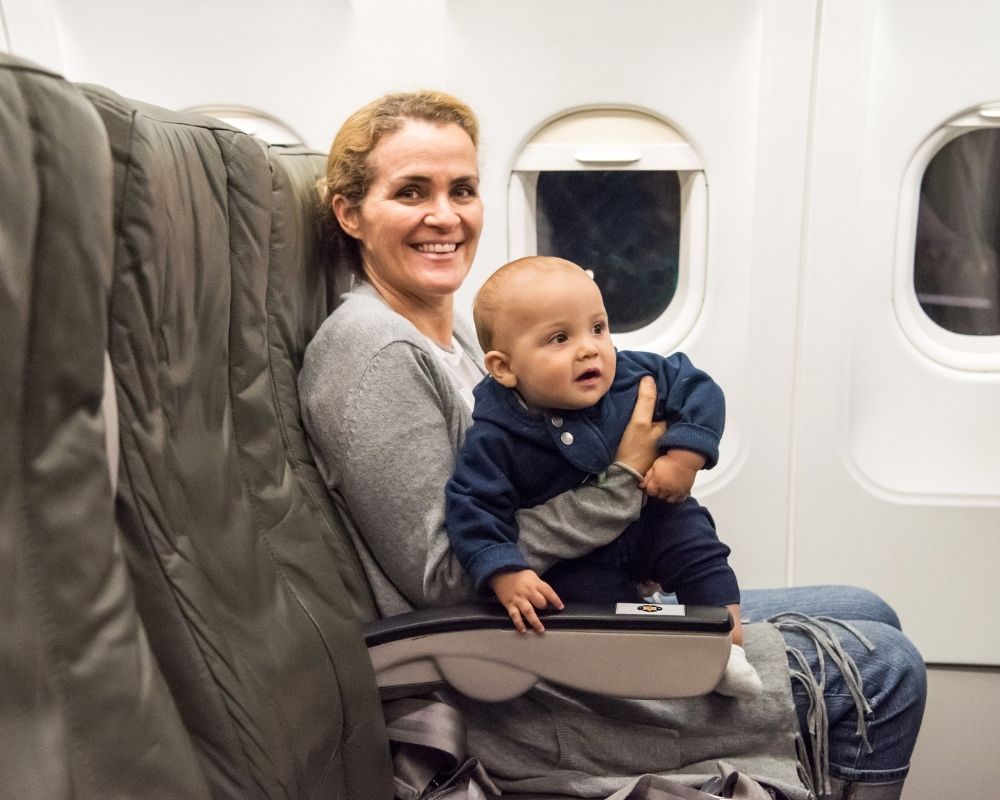Newborn baby only sleeping in your arms? Follow these tips to get your baby to sleep in a bassinet.

When you were pregnant, you probably put a lot of thought into picking out a bassinet. You also probably pictured your sweet baby all cozy and sleeping away in their bassinet.
Then, reality hit and you realized you have a baby who seems to hate their bassinet.
Does that sound familiar?
If so, you are not alone!
Read on to see my best tips for getting your baby to sleep in a bassinet.
Want a realistic newborn sleep schedule? Download my free newborn sleep schedule to see what a day with your newborn might look like. Click here to grab it. It’ll be super helpful.Why Won’t My Newborn Sleep in the Bassinet?
There may be a few reasons why your baby isn’t sleeping in their bassinet.
Let’s go through them and help troubleshoot so you can get your baby to sleep without being held.
It’s an Unfamiliar Sleep Space
The womb is cozy and confined by the time a baby reaches term. It is also familiar and all they have ever known!
None of us remembers being a newborn, but I imagine most newborns find their bassinet to be a flat, large, uncomfortable space in comparison.
If feels far from you
Babies spend their life before birth with their senses full of all things mom. Being in a bassinet without constantly hearing, feeling, and smelling you can be an adjustment.
Baby can’t sleep due to discomfort
Sometimes babies have a hard time sleeping if they are hot, cold, hungry, or need a diaper change.
It’s worth running through a mental checklist to see if any of those things may be the case if your baby is having a hard time sleeping in their bassinet.
Baby simply can’t sleep
Sometimes we put babies down when they just aren’t ready to sleep. A baby who isn’t ready for sleep isn’t going to sleep no matter how ideal the setting.
How Do I Get My Newborn to Sleep in His Bassinet?
If your baby wants to be held for every sleep it can be exhausting for you.
Contact naps can be great some of the time.
But you and I both know that contact naps aren’t sustainable for the long term. The earlier a baby learns how to nap alone in their bassinet, the easier the learning curve often is.
Follow these tips to get your baby to sleep in their bassinet:
Make Sure Baby Isn’t Overtired
An overtired baby will have a hard time falling asleep and staying asleep.
Your newborn’s wake windows are super short—about 45 to 60 minutes.
Make sure to put your baby down in their bassinet after their wake window is up to avoid trying to put down an overtired baby.
Use White Noise
Silence can be so loud for newborn babies. After all, the womb was noisy!
When you’re putting your baby down for sleep in their bassinet, make sure to use a white noise sound machine.
Keep the sound machine 7 feet away from your baby and keep the decibel level around 50dB.
Create a Dark Room
We want to reduce distractions and keep your baby from getting overstimulated.
Use blackout curtains to create a dark room, which can help reduce stimulation.
Swaddle Your Baby
That bassinet can feel so big for your baby who was used to being snuggled up in the womb. Use a swaddle to help recreate the feeling of the womb.
I recommend swaddling for naps and nights.
Make the Bassinet Feel Like Mom
Your baby is used to your smells and feels.
Try sleeping with the bassinet sheet or your baby’s swaddle to get your scent on it. Then you can sleep your baby in it the next day.
Providing some comforts of mom may help them sleep better even if you’re not right there.
Use the Soothing Ladder
When you are ready to try for bassinet naps, using the soothing ladder can be helpful. There are multiple variations of this and you can create one that works for you.
The basic premise of a soothing ladder is you put your baby in their bassinet awake and then offer increasing amounts of soothing as needed until your baby either falls asleep in the bassinet or needs to be picked up and soothed to sleep.
Over time, you’ll find yourself not needing to go as far up the soothing ladder and eventually will find your baby falling asleep easily in their bassinet.
Focus on Nights
Naps can be especially challenging in the newborn phase. Short naps are common and so are contact naps.
Don’t put too much pressure on yourself by trying to get every sleep in the bassinet or crib.
Focus on getting your baby to sleep in their bassinet at night first.
Then, you can start practicing on just one nap of the day.
Practice
In my experience, it takes intentionality and lots of practice to move from your baby sleeping while being held to sleeping in a bassinet.
Patience and persistence are important if you want to help your baby sleep in his bassinet.
Don’t give up if it doesn’t happen the first, second, or even 10th time you try.
Why Does My Newborn Wake Up As Soon As I Put Her Down?
Does your newborn fall asleep peacefully but then wake up as soon as you transfer her to the bassinet or crib?
You’re not alone!
Some babies can be extra sensitive to the transfer. If you want to attempt it, follow these tips.
Wait A Bit
If your baby just fell asleep, don’t try to transfer them just yet.
Wait a good 15–20 minutes to make sure they go into a deep sleep before you attempt to move them.
Try a Soothing Method
Keep baby in the bassinet and use a soothing method like the Shush Pat. This can help calm baby and help soothe them back to sleep.
Make sure to really commit to the Shush Pat and not just try it for 5 minutes or so.
Should A Newborn Sleep in the Bassinet During the Day?
Daytime naps are a great time to practice bassinet sleep, but don’t get discouraged if not every nap happens in the crib or bassinet.
It’s common to have several contact naps, on-the-go-naps, and stroller naps during the newborn phase.
If you want to try to get your newborn to nap in their bassinet, It’s usually easiest to practice the first nap of the day in the bassinet. That first morning nap is typically the easiest ones for babies to take.
If you want to practice multiple naps a day in the bassinet, that is okay too.
Just make sure you feel good about trying for bassinet naps and that you or your baby aren’t getting discouraged if it takes your baby too long to fall asleep.
Being locked in a cycle of overtiredness won’t help anything when it comes to bassinet sleep!
Use your soothing ladder and don’t be afraid to soothe to sleep if needed.
What to Do If Your Baby Won’t Sleep in the Bassinet
What should you do if your baby just won’t sleep in the bassinet no matter what?
First, don’t be discouraged.
Your baby eventually will sleep in their own bed. There’s no such thing as being too old to learn independent sleep. I see plenty of babies learn how to do it in the first few months of life and many others who don’t even start practicing until toddlerhood.
You can start working on independent sleep when it’s the right time for you and your family.
If your baby seems very fussy and just won’t settle, consider checking in with your pediatrician to make sure there are no medical concerns that could be making your baby uncomfortable.
If you’d like more help with your newborn’s sleep, take a look at my newborn sleep program. Perfect for new babies 0-3 months of age, it walks you through an age-appropriate way to help your precious little one sleep better.
Get Your Newborn to Sleep

Learn how to get your newborn to fall asleep and stay asleep with the Newborn Sleep Course. You’ll learn expert sleep tips for soothing your baby to sleep, establishing easy routines, and how to start reducing night feeds when your newborn is ready. Learn more here.
Questions about how to get your baby to sleep in the bassinet? Drop them below and we’ll help you troubleshoot.
- Practical Tips if your Toddler is Going Through A 3-Year Old Sleep Regression - April 26, 2024
- Baby Led Weaning vs Purees — Which Should I Choose? - April 25, 2024
- 10 Adorable Letter Board Pregnancy Announcements - April 25, 2024






